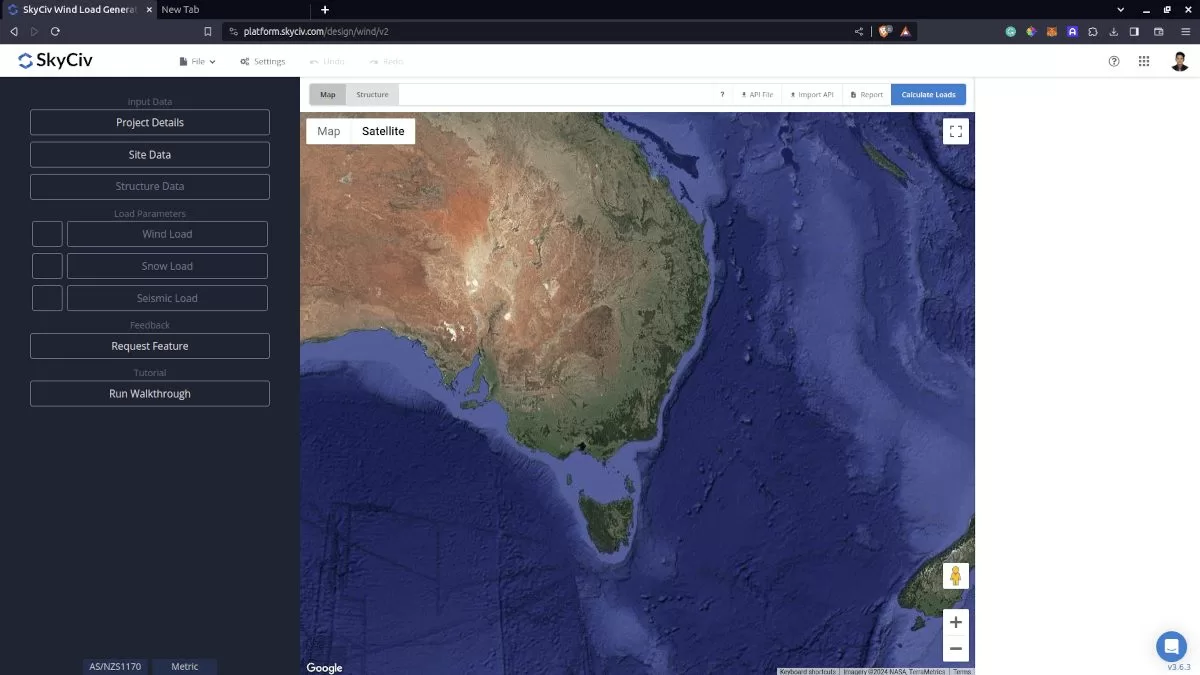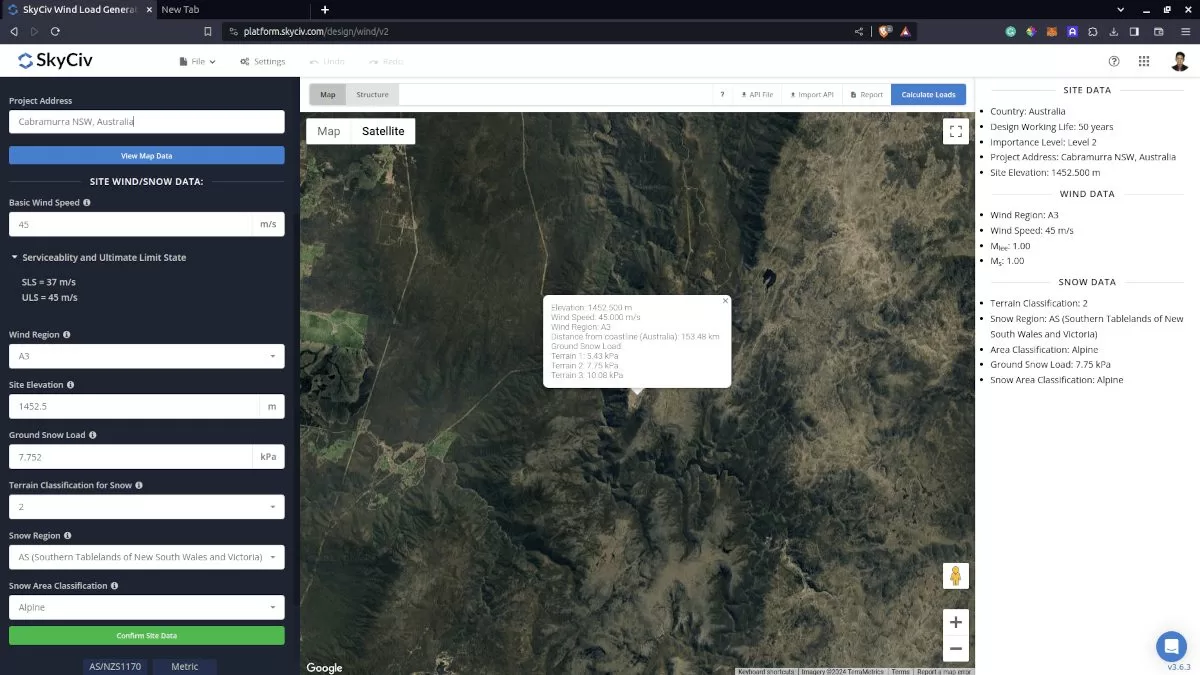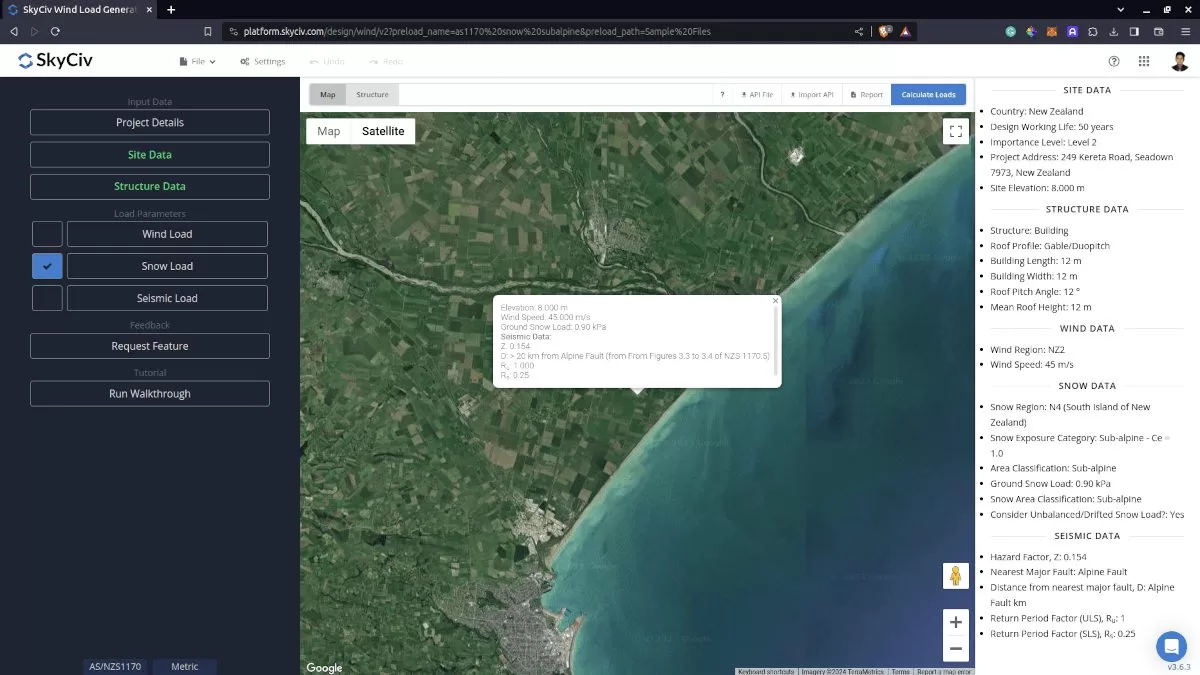Using the SkyCiv Load Generator in AS/NZS 1170.3 Snow Load Calculations
To calculate the snow load pressures for a structure using SkyCiv Load Generator, the process is to define first the code reference. However, only users with a Professional Account or who purchased the standalone Load Generator module will be able to use this calculation. You can purchase the standalone module thru this link.

Figure 1. SkyCiv Load Generator UI.
Site Data
Using the AS/NZS 1170.3 snow load calculation, you just need to define the following parameters:
- Country – Australia or New Zealand
- Design Working Life – how long the structure is intended to be used. For instance, is the structure used for construction purposes (e.g. scaffolding) or is the design working life longer term, for say buildings and bridges. The longer the design working life, the higher the basic wind speed (to account for significance). Here, the SLS only increases up to DWL of less than 25 years.
- Importance Level – The importance level is governed the type of structure and it’s potential impact. Click the (i) for more information about which importance level is correct for your structure.
- Project Address – the address where the site is located
After selecting the options for these parameters, you need to put the address of the structure. The corresponding snow load for the address will be automatically calculated. Take note that this value is based on the following:
- Section 2 of AS/NZS 1170.3 for classification of snow regions based on Figures 2.1 and 2.2 and based on elevation
- Table 5.2 for specific locations in Australia
Take note that the snow region classification automatically displayed in the module shall prioritize the classification of the area based on elevation. To display the snow region map based on Figures 2,1 and 2.2, you need to click “View Map Contours” and then select “Snow” – “Australia/New Zealand.” For Australian locations indicated in Table 5.2, the user should select “Terrain Classification for Snow” as given in AS/NZS 1170.3 Supp 1.

Figure 2. Site data of SkyCiv Load Generator
SkyCiv has digitalized the map as per the paperback standard. This means, you can simply enter in the site location and the software will automatically pull the ground snow load based on this input. There is a limit to how many times the ground snow load can be obtained on the free tool.
Structure Data
Next step is to define first the Structure you are analyzing. Currently, only Building structure is supported in AS/NZS 1170.3.

Figure 3. Structure data input for buildings.
Structure Input Parameters for Snow Load Calculation
Roof Profile – Used in pressure coefficient values based on the selected roof profile and roof pitch angle
Building Length – the dimension parallel to the wind direction as defined in AS/NZS 1170.
Building Width – the dimension perpendicular to the wind direction as defined in AS/NZS 1170.
Mean Roof Height – the dimension of the structure from ground to the middle height of the sloping roof.
Roof Pitch Angle – the roof slope in degree. Use our pitch roof calculator if you need to determine this.
Once the parameters above are completed and validated (clicking Confirm Structure Data), we can now proceed to the Snow Load Parameters section.
Snow Data
To proceed with our snow load calculation, we need to check the checkbox first beside the Snow Load button. By default, this is checked when the site snow data has been defined.

Figure 4. Checkbox for Snow Load Data.
Snow Input Parameters

Figure 5. Snow Load Input Parameters.
Snow Exposure Category
This parameter is used in getting Exposure Reduction Coefficient Ce. The definition of each option is defined in table below:
| Exposure Category | Definition |
|---|---|
| Sub-alpine | Sites classified as sub-alpine region. |
| Sheltered | Sites where roof is protected from the wind by obstructions such as other structures, terrain features or numbers of closely spaced trees higher than the roof. |
| Semisheltered | Sites where roof is only partially protected by numbers of scattered obstructions higher than the roof (e.g., scattered trees). |
| Windswept | Sites where the roof is exposed on all sides, with no protection provided by obstructions, trees, or terrain features higher than the roof. |
Consider Unbalanced/Drifted Snow Load Case?
This parameter is a “Yes” or “No” to calculate for Unbalanced Snow Load Case. Upon selecting “No,” the balanced snow load case shall only be calculated. On the other hand, upon selecting “Yes,” the unbalanced snow load case table will show. There are four options for AS/NZS 1170.3 alpine region:
Drift on duopitch roof
This case is used to calculate the drifted snow load on duopitch/gable roof as shown below:

Drift on monopitch roof
This case is used to calculate the drifted snow load on monopitch/monoslope roof as shown below:

Figure 7. Parameters for calculating drifted snow load on monopitch/monoslope roof.
Drift on lower roof
This case is used to calculate the snow load drift on lower roof level.

Drift on projections and obstruction
This case is used to calculate the snow load drift on obstructions above the roof level such as parapet walls, firewalls, chimneys, etc.

Figure 9. Parameters for calculating drifted snow load on obstructions and projections above the roof.
Drift on obstructed roof with parapet
This case is used to calculate the snow load drift on parapet walls in sub-alpine region.

Figure 10. Parameters for calculating drifted snow load on obstructed roof with parapet in sub-alpine region.
Drift on obstructed roof with abutting
This case is used to calculate the snow load drift on obstructed roof with abutting in sub-alpine region.

Figure 11. Parameters for calculating drifted snow load on obstructed roof with abutting in sub-alpine region.
Results
The snow load results will show the parameters in calculating the balanced snow load as shown below. The summarized results are shown on the right side of the screen. Other results are shown on the detailed report.

Figure 12. Snow load parameters and balanced snow load results.

Figure 13. Drifted snow load results.
Detailed Calculation
The detailed snow load calculations can be accessed only by Professional account users and those who purchased the standalone load generator module. All the parameters and assumptions used in the calculation are displayed on the report to make it transparent to the user. You can download a sample detailed calculation thru the following links:



